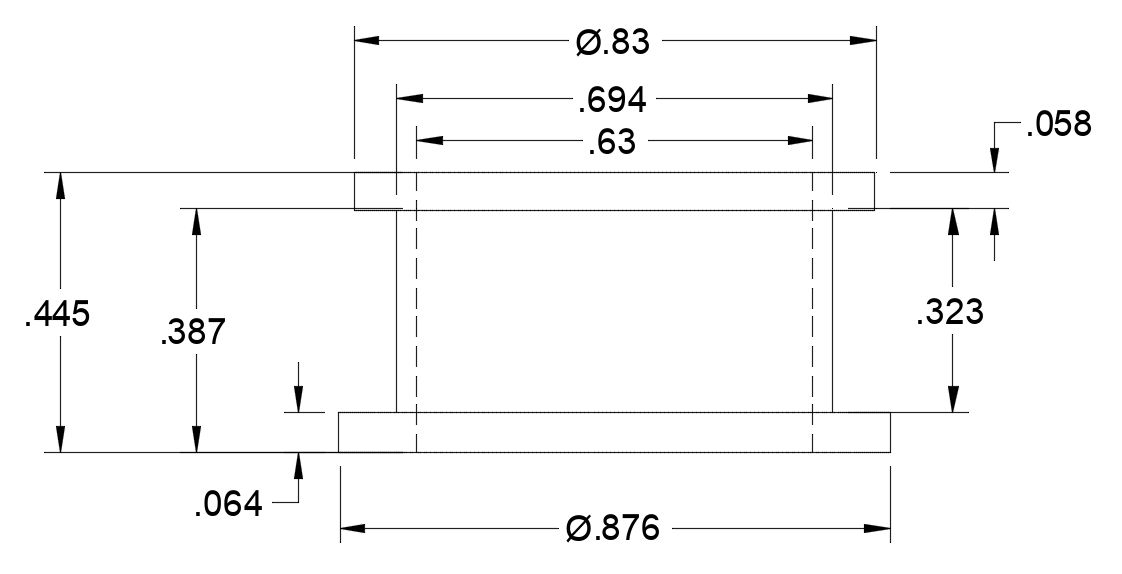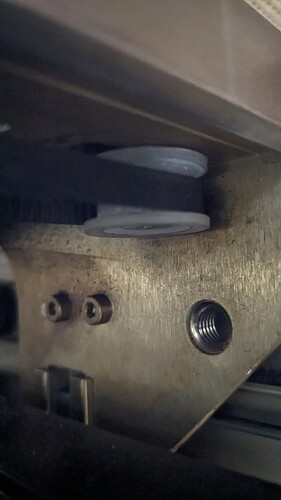My tensioner pulley disintegrated, (as they do), and they’re out of stock, (as it goes).
I don’t have a 3d printer, but I do have a lathe, so I took measurements from the broken parts, and cross-referenced with the 3d print model that’s floating around, and made one from ABS rod.
Here’s a drawing with the dimensions I took (and used; mostly), and it seems to be working, so maybe someone else will find it useful too.
I completely forgot to make one flange smaller than the other, but it doesn’t seem to be a problem to make them both the larger size. It’s not exactly a high-precision part  Don’t read too much into the precision of the values given in the drawing; I don’t know what I’m doing with machining, really.
Don’t read too much into the precision of the values given in the drawing; I don’t know what I’m doing with machining, really.
In fact you probably want the ID to be on the small size, depending on your material. I would have liked a tighter fit on the pre-existing bearings, as the rim is so thin it stretched when pushing them in. A tighter interference fit would have been nice; maybe 5/8".
If you’re replacing the tensioner, I don’t think the dimensions are particularly critical, but I suspect that if you’re replacing the other two locations (the side belts) then you really want them to be the same.
23 Likes
This is excellent on several levels. Got a picture of your handmade wheel?
7 Likes
I didn’t take one before I installed it – but here’s a (bad; poor lighting) shot of it installed.
I had white ABS, but mostly I work metal out there, so white things get dingy almost immediately, and there was a lot of chatter in the grooving ops that I didn’t account for well, etc. etc… Anyway, it’s an ugly part ;).
18 Likes
Even if you say it’s ugly, the fact that you could make it yourself and not have to order one, and that it works fine is so awesome! I have neither a lathe nor a 3D printer, so I’d be out of luck. I do have a friend who has a lathe though, although I don’t know whether I could get him to make me one or two. But I’m bookmarking this just in case!
7 Likes
Thanks! I do get a lot of satisfaction from fixing things like this, and it was good practice on the lathe.
You can buy them from a few folks with 3d printers (ebay, etsy), but this was faster for me, and I feel a bit better about using a solid material rather than filament. I’ve had a few 3d prints come apart in the past, although I don’t think that’s as much of a problem any more.
10 Likes
Not with resin printing. At least, not in my experience. Parts come out as hard as anything you could manufacture or buy.
7 Likes
Oh, great! The pulleys I’ve seen listed have all been filament 
I’ve heard only good things about the results from resin, but I haven’t had any personal experience yet.
3 Likes
I’ve had filament printers since they became viable consumer products. I have parts I made with my very first one (solidoodle) that are holding up just fine.
They can be fiddly, and I have had many failed prints. I’ll never use one again.
2 Likes
We are brethren. Nice fix, thanks for sharing, and welcome to the community!
It occurs to me, since there is the slide adjustment in the wheel anchor, making the wall for the bearing pocket thicker would only slightly increase the diameter, and wouldn’t interfere with its operation.
10 Likes
Agreed. There’s quite a bit of tolerance due to the flex in the belt, you could go 1mm thicker all around the central hub and it wouldn’t make any difference.
7 Likes
Great post @creswick and welcome to the community!
Thanks for sharing this with us. You never know when this might come in handy.
We look forward to see what you create with your  .
.
5 Likes
![]() Don’t read too much into the precision of the values given in the drawing; I don’t know what I’m doing with machining, really.
Don’t read too much into the precision of the values given in the drawing; I don’t know what I’m doing with machining, really.
